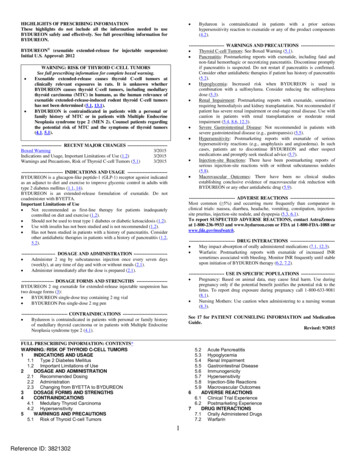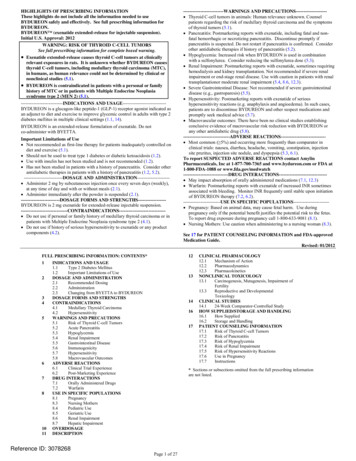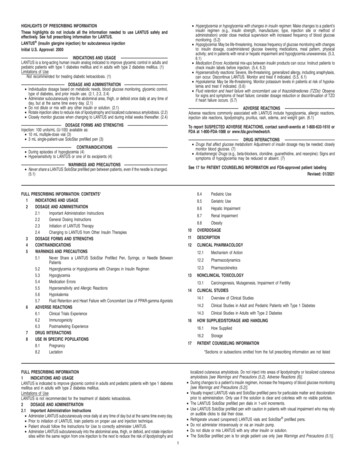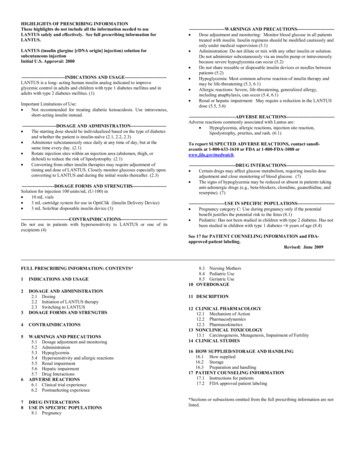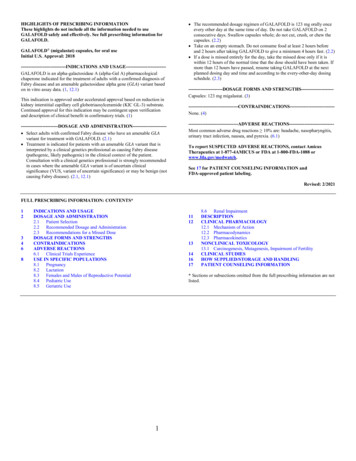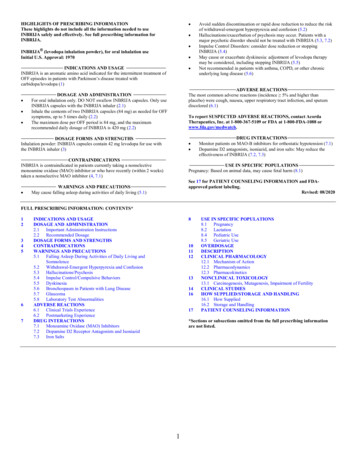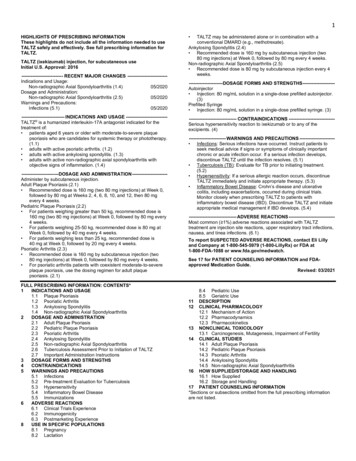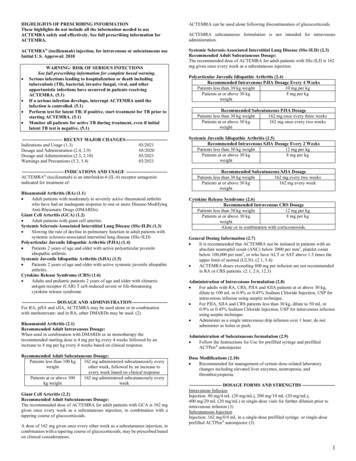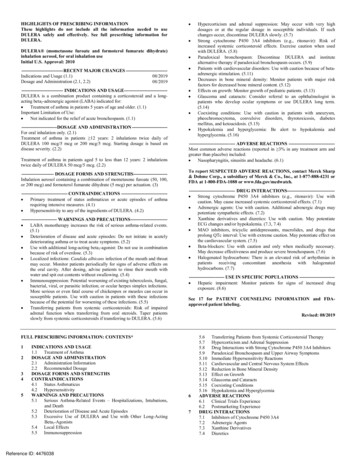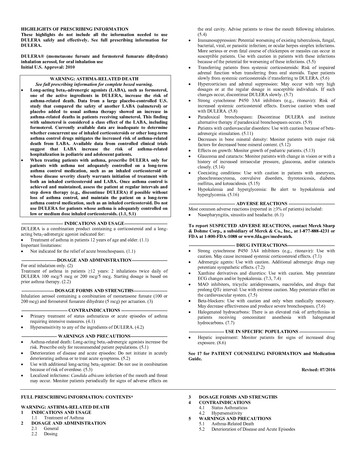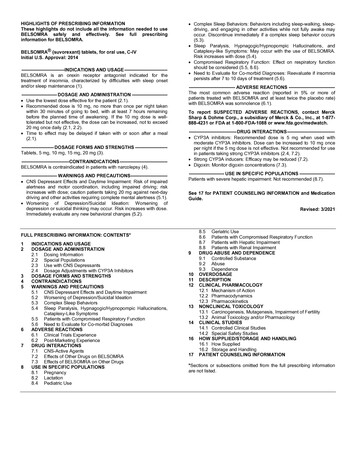
Transcription
HIGHLIGHTS OF PRESCRIBING INFORMATIONThese highlights do not include all the information needed to usePLEGRIDY safely and effectively. See full prescribing information forPLEGRIDY. PLEGRIDY (peginterferon beta-1a) injection, for subcutaneous injectionInitial U.S. Approval: 2014RECENT MAJOR CHANGESIndications and Usage (1)07/2019INDICATIONS AND USAGEPLEGRIDY is an interferon beta indicated for the treatment of relapsingforms of multiple sclerosis (MS), to include clinically isolated syndrome,relapsing-remitting disease, and active secondary progressive disease, inadults (1) DOSAGE AND ADMINISTRATIONFor subcutaneous use only (2.1)Recommended dose: 125 micrograms every 14 days (2.1)PLEGRIDY dose should be titrated, starting with 63 micrograms on day1, 94 micrograms on day 15, and 125 micrograms (full dose) on day 29(2.1)A healthcare professional should train patients in the proper techniquefor self-administering subcutaneous injections using the prefilled pen orsyringe (2.2)Analgesics and/or antipyretics on treatment days may help ameliorateflu-like symptoms (2.3)DOSAGE FORMS AND STRENGTHSInjection: 125 micrograms per 0.5 mL solution in a single-dose prefilledpen (3)Injection Starter Pack: 63 micrograms per 0.5 mL solution in a singledose prefilled pen and 94 micrograms per 0.5 mL solution in a singledose prefilled pen (3)Injection: 125 micrograms per 0.5 mL solution in a single-dose prefilledsyringe (3)Injection Starter Pack: 63 micrograms per 0.5 mL solution in a singledose prefilled syringe and 94 micrograms per 0.5 mL solution in asingle-dose prefilled syringe (3) CONTRAINDICATIONSHistory of hypersensitivity to natural or recombinant interferon beta orpeginterferon, or any other component of the formulation (4) WARNINGS AND PRECAUTIONSHepatic injury: monitor liver function tests; monitor patients for signsand symptoms of hepatic injury; consider discontinuation ofPLEGRIDY if hepatic injury occurs (5.1)Depression and suicide: advise patients to report immediately anysymptom of depression or suicidal ideation to their healthcare provider;consider discontinuation of PLEGRIDY if depression occurs (5.2)Seizure: Seizures are associated with the use of interferon beta. Exercisecaution when administering PLEGRIDY to patients with a seizuredisorder (5.3)Anaphylaxis and other allergic reactions: serious allergic reactions havebeen reported as a rare complication of treatment with interferon beta.Discontinue PLEGRIDY if a serious allergic reaction occurs (5.4)Injection site reactions: change injection site or consider discontinuationof PLEGRIDY if there is necrosis (5.5)Congestive heart failure: monitor patients with pre-existing significantcardiac disease for worsening of cardiac symptoms (5.6)Decreased peripheral blood counts: monitor complete blood counts (5.7)Thrombotic Microangiopathy: Cases of thrombotic microangiopathyhave been reported with interferon beta products. DiscontinuePLEGRIDY if clinical symptoms and laboratory findings consistent withTMA occur (5.8)Autoimmune disorders: consider discontinuation of PLEGRIDY if anew autoimmune disorder occurs (5.9)ADVERSE REACTIONSThe most common adverse reactions (incidence 10% and at least 2% morefrequent on PLEGRIDY than on placebo) were injection site erythema,influenza-like illness, pyrexia, headache, myalgia, chills, injection site pain,asthenia, injection site pruritus, and arthralgia (6.1)To report SUSPECTED ADVERSE REACTIONS, contact Biogen at 1 800-456-2255 or FDA at 1-800-FDA-1088 or www.fda.gov/medwatch. USE IN SPECIFIC POPULATIONSPregnancy: Epidemiological data do not suggest a clear relationshipbetween interferon beta use and major congenital malformations, butinterferon beta may cause fetal harm based on animal data (8.1)Severe Renal Impairment: monitor for adverse reactions (8.6)See 17 for PATIENT COUNSELING INFORMATION and MedicationGuideRevised: 03/2020FULL PRESCRIBING INFORMATION: CONTENTS*1234568INDICATIONS AND USAGEDOSAGE AND ADMINISTRATION2.1 Dosing Information2.2 Important Administration Instructions (All Dosage Forms)2.3 Premedication for Flu-like SymptomsDOSAGE FORMS AND STRENGTHSCONTRAINDICATIONSWARNINGS AND PRECAUTIONS5.1 Hepatic Injury5.2 Depression and Suicide5.3 Seizures5.4 Anaphylaxis and Other Allergic Reactions5.5 Injection Site Reactions5.6 Congestive Heart Failure5.7 Decreased Peripheral Blood Counts5.8 Thrombotic Microangiopathy5.9 Autoimmune DisordersADVERSE REACTIONS6.1Clinical Trials ExperienceUSE IN SPECIFIC POPULATIONS8.1 Pregnancy8.2 Lactation8.4 Pediatric Use111213141617*Sections or subsections omitted from the full prescribing information are notlisted.1Reference ID: 45826278.5 Geriatric Use8.6 Renal ImpairmentDESCRIPTION11.1 PLEGRIDY PEN Single-Dose Prefilled Pen11.2 PLEGRIDY Single-Dose Prefilled SyringeCLINICAL PHARMACOLOGY12.1 Mechanism of Action12.2 Pharmacodynamics12.3 PharmacokineticsNONCLINICAL TOXICOLOGY13.1 Carcinogenesis, Mutagenesis, Impairment of FertilityCLINICAL STUDIESHOW SUPPLIED/STORAGE AND HANDLING16.1 PLEGRIDY PEN Single-Dose Prefilled Pen16.2 PLEGRIDY Single-Dose Prefilled Syringe16.3 Storage and Handling16.4 Instructions for DisposalPATIENT COUNSELING INFORMATION
FULL PRESCRIBING INFORMATION1INDICATIONS AND USAGEPLEGRIDY is indicated for the treatment of relapsing forms of multiple sclerosis (MS), toinclude clinically isolated syndrome, relapsing-remitting disease, and active secondaryprogressive disease, in adults.2DOSAGE AND ADMINISTRATION2.1Dosing InformationPLEGRIDY is administered subcutaneously.The recommended dosage of PLEGRIDY is 125 micrograms injected subcutaneously every 14days.Treatment initiationPatients should start treatment with 63 micrograms on day 1. On day 15 (14 days later), the doseis increased to 94 micrograms, reaching the full dose of 125 micrograms on day 29 (after another14 days). Patients continue with the full dose (125 micrograms) every 14 days thereafter (seeTable 1). A PLEGRIDY Starter Pack is available containing two prefilled pens or syringes: 63micrograms (dose 1) and 94 micrograms (dose 2).Table 1:Schedule for Dose TitrationDoseTime*Amount (micrograms)Color of Pen orSyringe LabelDose 1On day 163OrangeDose 2On day 1594BlueDose 3On day 29 and every 14days thereafter125 (full dose)Grey*Dosed every 14 days2.2Important Administration Instructions (All Dosage Forms)Healthcare professionals should train patients in the proper technique for self-administeringsubcutaneous injections using the prefilled pen or syringe. Patients should be advised to rotatesites for subcutaneous injections. The usual sites for subcutaneous injections are abdomen, backof the upper arm, and thigh.Each PLEGRIDY pen and syringe is provided with the needle pre-attached. Prefilled pens andsyringes are for a single dose only and should be discarded after use.2Reference ID: 4582627
2.3Premedication for Flu-like SymptomsProphylactic and concurrent use of analgesics and/or antipyretics may prevent or ameliorate flulike symptoms sometimes experienced during treatment with PLEGRIDY.3DOSAGE FORMS AND STRENGTHSPen Injection: 125 micrograms of PLEGRIDY per 0.5 mL of solution in a single-dose prefilledpen Injection: Starter Pack containing 63 micrograms per 0.5 mL of solution in a single-doseprefilled pen and 94 micrograms per 0.5 mL solution in a single-dose prefilled penPrefilled Syringe Injection: 125 micrograms of PLEGRIDY per 0.5 mL of solution in a single-dose prefilledsyringe Injection: Starter Pack containing 63 micrograms per 0.5 mL of solution in a single-doseprefilled syringe and 94 micrograms per 0.5 mL of solution in a single-dose prefilled syringe4CONTRAINDICATIONSPLEGRIDY is contraindicated in patients with a history of hypersensitivity to natural orrecombinant interferon beta or peginterferon, or any other component of the formulation [seeWarnings and Precautions (5.4)].5WARNINGS AND PRECAUTIONS5.1Hepatic InjurySevere hepatic injury, including hepatitis, autoimmune hepatitis, and rare cases of severe hepaticfailure, have been reported with interferon beta. Asymptomatic elevation of hepatictransaminases has also been reported, and in some patients has recurred upon rechallenge withinterferon beta.Elevations in hepatic enzymes and hepatic injury have been observed with the use ofPLEGRIDY in clinical studies. The incidence of increases in hepatic transaminases was greaterin patients taking PLEGRIDY than in those taking placebo. The incidence of elevations ofalanine aminotransferase above 5 times the upper limit of normal was 1% in placebo-treatedpatients and 2% in PLEGRIDY-treated patients. The incidence of elevations of aspartateaminotransferase above 5 times the upper limit of normal was less than 1% in placebo-treatedpatients and less than 1% in PLEGRIDY-treated patients. Elevations of serum hepatic3Reference ID: 4582627
transaminases combined with elevated bilirubin occurred in 2 patients. Both cases resolvedfollowing discontinuation of PLEGRIDY.Monitor patients for signs and symptoms of hepatic injury.5.2Depression and SuicideDepression, suicidal ideation, and suicide occur more frequently in patients receiving interferonbeta than in patients receiving placebo.In clinical studies, the overall incidence of adverse events related to depression and suicidalideation in multiple sclerosis patients was 8% in both the PLEGRIDY and placebo groups. Theincidence of serious events related to depression and suicidal ideation was similar and less than1% in both groups.Advise patients to report immediately any symptom of depression or suicidal ideation to theirhealthcare provider. If a patient develops depression or other severe psychiatric symptoms,consider stopping treatment with PLEGRIDY.5.3SeizuresSeizures are associated with the use of interferon beta.The incidence of seizures in multiple sclerosis clinical studies was less than 1% in patientsreceiving PLEGRIDY and placebo.Exercise caution when administering PLEGRIDY to patients with a seizure disorder.5.4Anaphylaxis and Other Allergic ReactionsAnaphylaxis and other serious allergic reactions are rare complications of treatment withinterferon beta.Less than 1% of PLEGRIDY-treated patients experienced a serious allergic reaction such asangioedema or urticaria. Those who did have serious allergic reactions recovered promptly aftertreatment with antihistamines or corticosteroids.Discontinue PLEGRIDY if a serious allergic reaction occurs.5.5Injection Site ReactionsInjection site reactions, including injection site necrosis, can occur with the use of subcutaneousinterferon beta.In clinical studies, the incidence of injection site reactions (e.g., injection site erythema, pain,pruritus, or edema) was 66% in the PLEGRIDY group and 11% in the placebo group; theincidence of severe injection site reactions was 3% in the PLEGRIDY group and 0% in theplacebo group. One patient out of 1468 patients who received PLEGRIDY in clinical studiesexperienced injection site necrosis. The injury resolved with standard medical treatment.Decisions to discontinue therapy following necrosis at a single injection site should be based onthe extent of the necrosis. For patients who continue therapy with PLEGRIDY after injection4Reference ID: 4582627
site necrosis has occurred, avoid administration of PLEGRIDY near the affected area until it isfully healed. If multiple lesions occur, discontinue PLEGRIDY until healing occurs.5.6Congestive Heart FailureCongestive heart failure, cardiomyopathy, and cardiomyopathy with congestive heart failureoccur in patients receiving interferon beta.In clinical studies, the incidence of cardiovascular events was 7% in both PLEGRIDY andplacebo treatment groups. No serious cardiovascular events were reported in the PLEGRIDYgroup.Monitor patients with significant cardiac disease for worsening of their cardiac condition duringinitiation and continuation of treatment with PLEGRIDY.5.7Decreased Peripheral Blood CountsInterferon beta can cause decreased peripheral blood counts in all cell lines, including rareinstances of pancytopenia and severe thrombocytopenia.In clinical studies, decreases in white blood cell counts below 3.0 x 109/L occurred in 7% ofpatients receiving PLEGRIDY and in 1% receiving placebo. There is no apparent associationbetween decreases in white blood cell counts and an increased risk of infections or seriousinfections. The incidence of clinically significant decreases in lymphocyte counts (below 0.5 x109/L), neutrophil counts (below 1.0 x 109/L), and platelet counts (below 100 x 109/L) were allless than 1% and similar in both placebo and PLEGRIDY groups. Two serious cases werereported in patients treated with PLEGRIDY: one patient (less than 1%) experienced severethrombocytopenia (defined as a platelet count less than or equal to 10 x 109/L), and anotherpatient (less than 1%) experienced severe neutropenia (defined as a neutrophil count less than orequal to 0.5 x 109/L). In both patients, cell counts recovered after discontinuation ofPLEGRIDY. Compared to placebo, there were no significant differences in red blood cell countsin patients treated with PLEGRIDY.Monitor patients for infections, bleeding, and symptoms of anemia. Monitor complete blood cellcounts, differential white blood cell counts, and platelet counts during treatment withPLEGRIDY. Patients with myelosuppression may require more intensive monitoring of bloodcell counts.5.8Thrombotic MicroangiopathyCases of thrombotic microangiopathy (TMA), including thrombotic thrombocytopenicpurpura and hemolytic uremic syndrome, some fatal, have been reported with interferonbeta products. Cases have been reported several weeks to years after starting interferonbeta products. Discontinue PLEGRIDY if clinical symptoms and laboratory findings consistentwith TMA occur, and manage as clinically indicated.5Reference ID: 4582627
5.9Autoimmune DisordersAutoimmune disorders of multiple target organs including idiopathic thrombocytopenia, hyperand hypothyroidism, and autoimmune hepatitis have been reported with interferon beta.In clinical studies, the incidence of autoimmune disorders was less than 1% in both PLEGRIDYand placebo treatment groups.If patients develop a new autoimmune disorder, consider stopping PLEGRIDY.6ADVERSE REACTIONSThe following serious adverse reactions are discussed in more detail in other sections of labeling: Hepatic Injury [see Warnings and Precautions (5.1)] Depression and Suicide [see Warnings and Precautions (5.2)] Seizures [see Warnings and Precautions (5.3)] Anaphylaxis and Other Allergic Reactions [see Warnings and Precautions (5.4)] Injection Site Reactions [see Warnings and Precautions (5.5)] Congestive Heart Failure [see Warnings and Precautions (5.6)] Decreased Peripheral Blood Counts [see Warnings and Precautions (5.7)] Thrombotic Microangiopathy [see Warnings and Precautions (5.8)] Autoimmune Disorders [see Warnings and Precautions (5.9)]6.1Clinical Trials ExperienceBecause clinical trials are conducted under widely varying conditions, adverse reaction ratesobserved in the clinical trials of PLEGRIDY cannot be directly compared to rates in clinicaltrials of other drugs and may not reflect the rates observed in practice.In clinical studies (Study 1 and Study 2), a total of 1468 patients with relapsing multiple sclerosisreceived PLEGRIDY for up to 177 weeks (41 months), with an overall exposure equivalent to1932 person-years. A total of 1093 patients received at least 1 year, and 415 patients at least 2years of treatment with PLEGRIDY. A total of 512 and 500 patients, respectively, receivedPLEGRIDY 125 micrograms every 14 days or every 28 days during the placebo-controlledphase of Study 1 (year 1). The experience in year 2 of Study 1 and in the 2-year safety extensionstudy (Study 2) was consistent with the experience in the 1-year placebo-controlled phase ofStudy 1.In the placebo-controlled phase of Study 1, the most common adverse drug reactions forPLEGRIDY 125 micrograms subcutaneously every 14 days were injection site erythema,influenza-like illness, pyrexia, headache, myalgia, chills, injection site pain, asthenia, injectionsite pruritus, and arthralgia (all had incidence more than 10% and at least 2% more thanplacebo). The most commonly reported adverse event leading to discontinuation in patients6Reference ID: 4582627
treated with PLEGRIDY 125 micrograms subcutaneously every 14 days was influenza-likeillness (in less than 1% of patients).Table 2 summarizes adverse reactions reported over 48 weeks from patients treated in theplacebo-controlled phase of Study 1 who received subcutaneous PLEGRIDY 125 micrograms(n 512), or placebo (n 500), every 14 days.7Reference ID: 4582627
Table 2:Adverse reactions in the 48-week placebo-controlled phase of Study 1 with anincidence 2% higher for PLEGRIDY than for placeboPLEGRIDY(N 512)%Placebo(N Injection site erythema627Influenza like illness4713Pyrexia4515Chills175Injection site pain153Asthenia138Injection site pruritus131Hyperthermia41Pain53Injection site edema30Injection site warmth30Injection site hematoma31Injection site rash20Body temperature increased63Alanine aminotransferase increased63Aspartate aminotransferase increased42Gamma-glutamyl-transferase increased3141Nervous System DisordersHeadacheGastrointestinal DisordersMusculoskeletal and Connective TissueDisordersGeneral Disorders and Administration SiteConditionsInvestigationsSkin and Subcutaneous Tissue DisorderPruritus8Reference ID: 4582627
ImmunogenicityFor therapeutic proteins, there is a potential for immunogenicity. In Study 1, fewer than 1% ofpatients treated with PLEGRIDY every 14 days for 1 year developed neutralizing antibodies.Approximately 7% of PLEGRIDY-treated patients developed antibodies to PEG.The detection of antibody formation is highly dependent on the sensitivity and specificity of theassay. Additionally, the observed incidence of antibody (including neutralizing antibody)positivity in an assay may be influenced by several factors including assay methodology, samplehandling, timing of sample collection, concomitant medications, and underlying disease. Forthese reasons, comparison of the incidence of antibodies to PLEGRIDY with the incidence ofantibodies to other products may be misleading.Flu-Like SymptomsInfluenza-like illness was experienced by 47% of patients receiving PLEGRIDY 125micrograms every 14 days and 13% of patients receiving placebo. Fewer than 1% ofPLEGRIDY-treated patients in Study 1 discontinued treatment due to flu-like symptoms.8USE IN SPECIFIC POPULATIONS8.1PregnancyPregnancy Exposure RegistryThere is a pregnancy exposure registry that monitors pregnancy outcomes in women exposed toPLEGRIDY during pregnancy. Encourage patients to enroll by calling 1-866-810-1462 orvisiting https://www.plegridypregnancyregistry.com/.Risk SummaryData from a large population-based cohort study, as well as other published studies over severaldecades, have not identified a drug-associated risk of major birth defects with the use ofinterferon beta products during early pregnancy. Findings regarding a potential risk for low birthweight or miscarriage with the use of interferon beta products in pregnancy have beeninconsistent (see Data). In a study in pregnant monkeys, administration of interferon beta duringpregnancy resulted in an increased rate of abortion (see Data).In the U.S. general population, the estimated background risk of major birth defects andmiscarriage in clinically recognized pregnancies is 2-4% and 15-20%, respectively. Thebackground risk of major birth defects and miscarriage for the indicated population is unknown.DataHuman DataThe majority of observational studies reporting on pregnancies exposed to interferon betaproducts did not identify an association between the use of interferon beta products duringearly pregnancy and an increased risk of major birth defects.In a population-based cohort study conducted in Finland and Swed
HIGHLIGHTS OF PRESCRIBING INFORMATION These highlights do not include all the information needed to use PLEGRIDY safely and effectively. See full prescribing information for PLEGRIDY. PLEGRIDY (peginterferon beta-1a) injection, for subcutaneous injection
